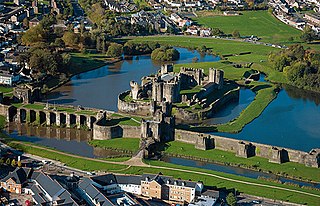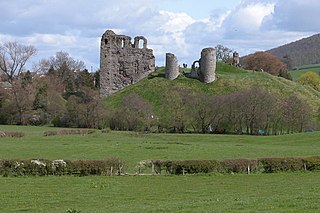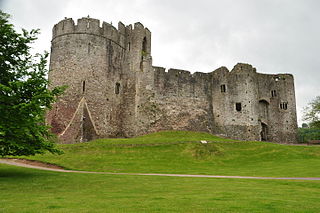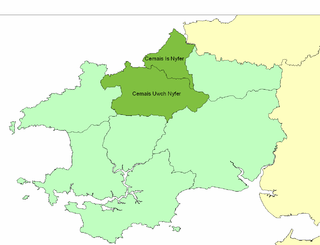
Pembroke Castle is a medieval castle in the centre of Pembroke, Pembrokeshire in Wales. The castle was the original family seat of the Earldom of Pembroke. A Grade I listed building since 1951, it underwent major restoration during the early 20th century.

Haverfordwest is the county town of Pembrokeshire, Wales, and the most populous urban area in Pembrokeshire with a population of 14,596 in 2011. It is also a community, being the second most populous community in the county, with 12,042 people, after Milford Haven. The suburbs include the former parish of Prendergast, Albert Town and the residential and industrial areas of Withybush.

Pembroke is a town and community in Pembrokeshire, Wales, with a population of 7,552. The names of both the town and the county have a common origin; both are derived from the Cantref of Penfro: Pen, 'head' or 'end', and bro, 'region', 'country', 'land', which has been interpreted to mean either 'Land's End' or 'headland'.

Caerphilly Castle is a medieval fortification in Caerphilly in South Wales. The castle was constructed by Gilbert de Clare in the 13th century as part of his campaign to maintain control of Glamorgan, and saw extensive fighting between Gilbert, his descendants, and the native Welsh rulers. Surrounded by extensive artificial lakes – considered by historian Allen Brown to be "the most elaborate water defences in all Britain" – it occupies around 30 acres (12 ha) and is the largest castle in Wales and the second-largest castle in the United Kingdom after Windsor Castle. It is famous for having introduced concentric castle defences to Britain and for its large gatehouses. Gilbert began work on the castle in 1268 following his occupation of the north of Glamorgan, with the majority of the construction occurring over the next three years at a considerable cost. The project was opposed by Gilbert's Welsh rival Llywelyn ap Gruffudd, leading to the site being burnt in 1270 and taken over by royal officials in 1271. Despite these interruptions, Gilbert successfully completed the castle and took control of the region. The core of Caerphilly Castle, including the castle's luxurious accommodation, was built on what became a central island, surrounding by several artificial lakes, a design Gilbert probably derived from that at Kenilworth. The dams for these lakes were further fortified, and an island to the west provided additional protection. The concentric rings of walls inspired Edward I's castles in North Wales, and proved what historian Norman Pounds has termed "a turning point in the history of the castle in Britain".

Newport is a town, community, electoral ward and ancient port of Parrog, on the Pembrokeshire coast in West Wales at the mouth of the River Nevern in the Pembrokeshire Coast National Park. The town gives its name to Newport Bay.

Clun Castle is a medieval ruined castle in Clun, Shropshire, England. Clun Castle was established by the Norman lord Robert de Say after the Norman invasion of England and went on to become an important Marcher lord castle in the 12th century, with an extensive castle-guard system. Owned for many years by the Fitzalan family, Clun played a key part in protecting the region from Welsh attack until it was gradually abandoned as a property in favour of the more luxurious Arundel Castle. The Fitzalans converted Clun Castle into a hunting lodge in the 14th century, complete with pleasure gardens, but by the 16th century the castle was largely ruined. Slighted in 1646 after the English Civil War, Clun remained in poor condition until renovation work in the 1890s.

Chepstow Castle at Chepstow, Monmouthshire, Wales, is the oldest surviving post-Roman stone fortification in Britain. Located above cliffs on the River Wye, construction began in 1067 under the instruction of the Norman Lord William FitzOsbern. Originally known as Striguil, it was the southernmost of a chain of castles built in the Welsh Marches, and with its attached lordship took the name of the adjoining market town in about the 14th century.

Cilgerran Castle is a 13th-century ruined castle located in Cilgerran, Pembrokeshire, Wales, near Cardigan. The first castle on the site was thought to have been built by Gerald of Windsor around 1110–1115, and it changed hands several times over the following century between English and Welsh forces. In the hands of William Marshal, 2nd Earl of Pembroke, the construction of the stone castle began after 1223.

Castell y Bere is a Welsh castle near Llanfihangel-y-pennant in Gwynedd, Wales. Constructed by Llywelyn the Great in the 1220s, the stone castle was intended to maintain his authority over the local people and to defend the south-west part of the princedom of Gwynedd. In 1282, war with Edward I of England resulted in the death of Llywelyn's grandson, Llywelyn ap Gruffudd, and Castell y Bere fell to English forces. Edward I expanded the castle further and established a small town beside it. In 1294 the Welsh leader Madog ap Llywelyn mounted a major revolt and the castle was besieged and apparently burnt. Edward did not repair it and it became ruined. Today it is in the hands of Cadw and operated as a tourist attraction.

Wiston Castle is a motte and bailey castle in the Pembrokeshire village of Wiston in south west Wales and is one of the best examples of its type in Wales. The castle and village were founded by Wizo, a Flemish settler who was granted the land by Henry I of England after he had wrested control from the previous owner, Arnulf de Montgomery. The castle was captured by the Welsh on several occasions but on each occasion it was retaken. It was abandoned during the thirteenth century when the then owner moved to nearby Picton Castle.

Milford Haven Waterway is a natural harbour in Pembrokeshire, Wales. It is a ria or drowned valley which was flooded at the end of the last ice age. The Daugleddau estuary winds west to the sea. As one of the deepest natural harbours in the world, it is a busy shipping channel, trafficked by ferries from Pembroke Dock to Ireland, oil tankers and pleasure craft. Admiral Horatio Nelson, visiting the haven with the Hamiltons, described it as the next best natural harbour to Trincomalee in Ceylon and "the finest port in Christendom". Much of the coastline of the Waterway is designated as a Site of Special Scientific Interest, listed as Milford Haven Waterway SSSI.

Grosmont Castle is a ruined castle in the village of Grosmont, Monmouthshire, Wales. The fortification was established by the Normans in the wake of the invasion of England in 1066, to protect the route from Wales to Hereford. Possibly commissioned by William fitz Osbern, the Earl of Hereford, it was originally an earthwork design with timber defences. In 1135, a major Welsh revolt took place, and in response King Stephen brought together Grosmont Castle and its sister fortifications of Skenfrith and White Castle to form a lordship known as the "Three Castles", which continued to play a role in defending the region from Welsh attack for several centuries.

Cemais was an ancient cantref of the Kingdom of Dyfed, from the 11th century a Norman Marcher Lordship, from the 16th century a Hundred, and is now part of Pembrokeshire, Wales. It occupied the coastal area between the Teifi estuary and Fishguard, and the northern and southern slopes of the Preseli Hills, covering an area of approximately 140 square miles (360 km2). The Afon Nyfer divided it into two commotes: Cemais Is Nyfer to the north and Cemais Uwch Nyfer to the south.

Gilbert Marshal, 4th Earl of Pembroke was the third son of William Marshal, 1st Earl of Pembroke and Countess Isabel, the daughter of Richard son of Gilbert, earl of Striguil. He was a member of the Marshal family.
This article is about the particular significance of the century 1201–1300 to Wales and its people.

Eva Marshal (1203–1246) was an Anglo-Norman noblewoman, daughter of William Marshal and Isabel de Clare, the Earl and Countess of Pembroke. She married William de Braose, a marcher lord.

Walter Marshal, 5th Earl of Pembroke was the fourth son of William Marshal, 1st Earl of Pembroke and Countess Isabel, the daughter of Richard son of Gilbert, earl of Striguil. He was a member of the Marshal Family.

Tenby Castle was a fortification standing on a headland separated by an isthmus from the town of Tenby, Pembrokeshire, Wales. The remaining stone structure dates from the 13th century but there are mentions of the castle from as early as 1153. It is a Grade II* listed building.

Newport Castle is a castle located in Newport, Pembrokeshire, Wales. The earliest castle on the site was built in the 13th century, and the present structure was built in the 19th century and is a private residence.
Morgan ap Hywel was Lord of Gwynllwg in Wales from about 1215 until his death in 1245, and for many years laid claim to the lordship of Caerleon, which had been seized by the Earl of Pembroke. For most of his life he was at peace with the English, at a time when there were periodic revolts by Welsh leaders against their rule. He may have participated in a crusade between 1227 and 1231.

























